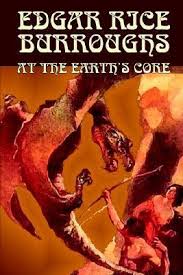Chapter I — At the earths core
byChapter I begins with David Innes reflecting on the pivotal decisions that led to the most unimaginable experience of his life. As the inheritor of a vast mining fortune, David chose to invest in innovation, particularly in a groundbreaking invention developed by his partner, Perry. The older scientist had designed a steel machine known as the “iron mole,” capable of drilling deep into the Earth’s crust—a marvel of engineering aimed at revolutionizing resource extraction. Fueled by ambition and curiosity, David financed its development and eagerly joined Perry in a trial run. What began as a test of human invention quickly unraveled into a descent beyond anything either of them had imagined. The moment the machine broke free from control, plunging them deeper than intended, their journey turned from scientific exploration to a fight for survival. Perry’s technical confidence began to give way to fear, and David’s youthful bravado started to erode under pressure.
Their descent continued, and with it came mounting complications. As the iron mole hurtled downward in a seemingly endless tunnel, any hope of redirecting it disappeared. The walls shook, temperature levels surged, and the confined space amplified every creak and groan from the machinery. Perry’s reactions grew less composed, shifting from methodical analysis to emotional distress. The irony of his sudden cursing—after years of devout behavior—added a layer of bitter humor to their situation. With fuel reserves nearing depletion and oxygen becoming scarce, panic began to replace strategy. David, although deeply anxious, remained more grounded, choosing to analyze their condition as a way to delay the onset of full dread. He found himself drawing strength from observing Perry’s weaknesses, not out of superiority, but out of necessity.
Then came the unexpected. As the mole passed the hottest point of their journey, a dramatic shift in temperature occurred. The intense heat, which had threatened to cook them alive, gave way to a sudden cold that neither man could logically explain. Perry, despite his scientific knowledge, could only offer speculation that defied everything he believed about subterranean structure. It was this reversal that first hinted they were not in a place science had ever fully understood. David, who had initially joined this experiment with limited technical knowledge, began to think more deeply about the strange mechanics of the world unfolding around them. As their bodies adapted to the cold and air grew thin, time itself seemed to stretch, blurring the line between minutes and hours. Each breath became a reminder of their diminishing chances.
In the moments where silence ruled and both men lay awaiting what seemed like the inevitable end, a different bond took shape between them. Perry, who had always been the intellect, began to lean on David for emotional stability. David, in return, came to appreciate Perry not just as a brilliant scientist but as a man burdened by the unknown. Their conversation, though fragmented and brief, shifted from fear to legacy—what they had tried to accomplish and what might become of it. It is in these moments of helplessness that the heart of human spirit becomes most evident. The darkness surrounding them was not just physical but metaphorical, and yet within it, a strange calm began to settle. Neither man could have anticipated what would happen next.
Just as they neared unconsciousness, something shifted once more. A soft jolt accompanied by a slight change in air pressure hinted at motion slowing. The iron mole, it seemed, had ceased its freefall and was now resting—or drifting—in some unknown cavity. David, fighting the fatigue and dizziness brought on by the lack of air, could barely comprehend what it meant. Had they reached a pocket of breathable atmosphere? Or had the machine merely come to rest in a tomb no one would ever find? These unanswered questions loomed large as David’s eyes finally closed, unsure whether he would ever open them again.
What makes this chapter more than just a mechanical mishap is its insight into the nature of exploration. It’s not just about technology or science—it’s about resilience, courage, and the willingness to face what lies beyond human knowledge. David and Perry, in their final shared breaths before falling into unconsciousness, embody that drive to push beyond the limits of the known world. It’s the kind of pursuit that defines humanity—not just to ask what’s possible, but to step into the abyss and find out for themselves.

